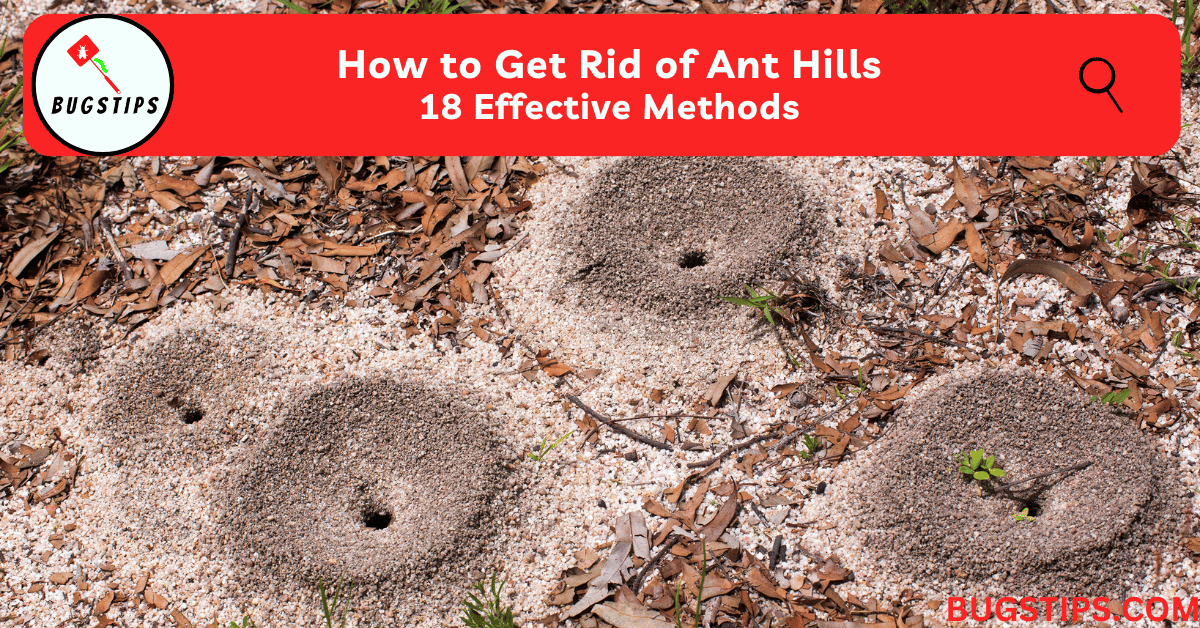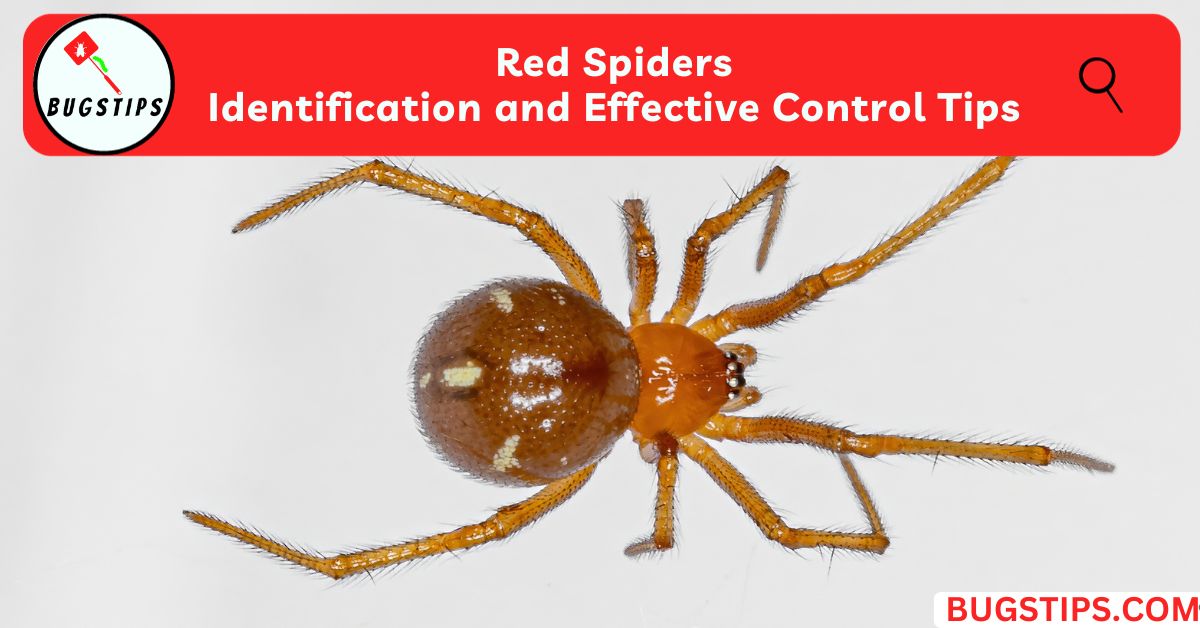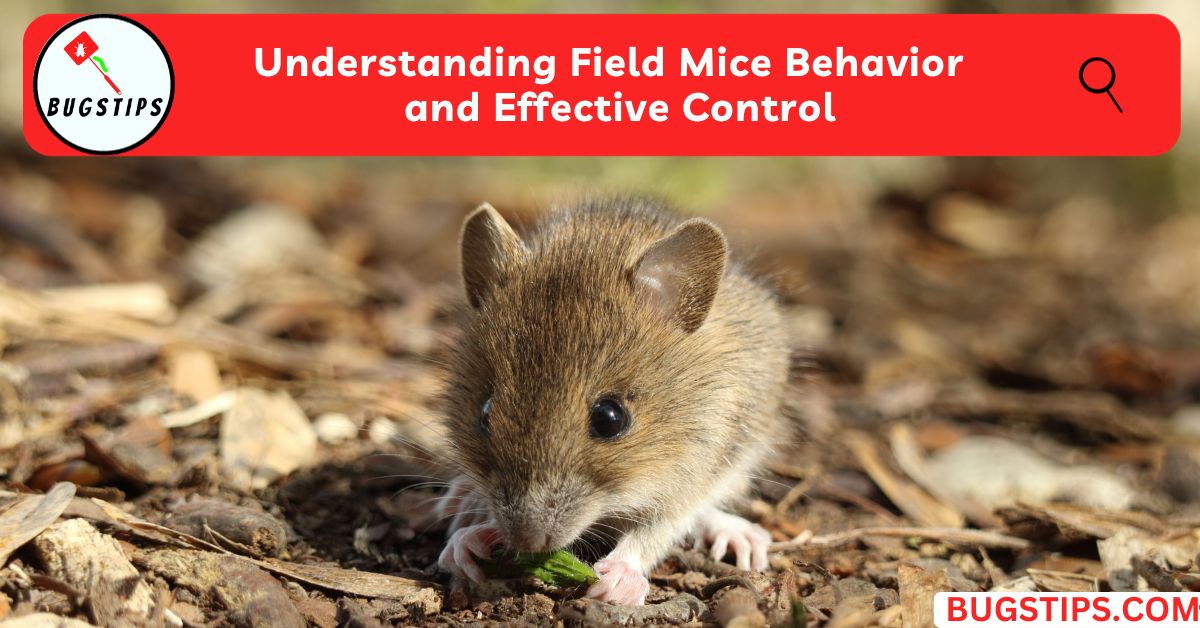This post may contain affiliate links which means as an Amazon Associate, this site may earn a small commission on qualified purchases made through links at no extra cost to you. Learn more on Affiliate Disclosure
Are you tired of seeing unsightly ant hills popping up all over your yard? Not only can they be an eyesore, but they can also cause damage to your lawn and garden.
If you’re wondering how to get rid of ant hills, you’ve come to the right place. In this article, we’ll explore different methods for eliminating ant hills, both chemically and naturally, as well as ways to prevent them from reappearing. So, grab your gardening gloves, and let’s get started!
What Are Ant Hills?
Ant hills are mounds of soil that are created by ants as they build their underground colonies. These colonies can be made up of hundreds or even thousands of ants, and the mounds themselves can range in size from just a few inches to several feet in diameter. Ant hills can be found in a variety of locations, including lawns, gardens, and even inside homes.
Related Article – Exploring Ant Hills: A Comprehensive Guide
Ant hills are typically built near sources of food and water, as well as in areas that offer protection from predators and harsh weather conditions. The mounds themselves are usually made up of a mixture of soil, saliva, and other materials that are brought up from the colony by the worker ants.
While ant hills may seem harmless, they can actually cause damage to your lawn and garden. The mounds can make it difficult to mow or walk on your lawn, and the ants themselves can damage plants and even bite humans or pets if they feel threatened. That’s why it’s important to take steps to get rid of ant hills as soon as you notice them.
Why Do I Have So Many Ant Hills in My Yard?
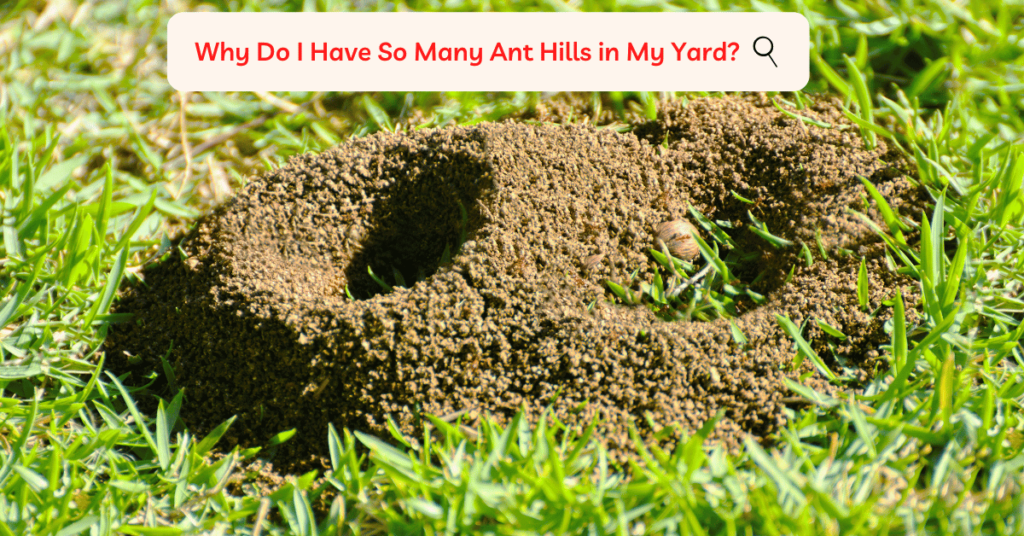
Ant hills can be a common sight in many yards, There are several reasons why ant hills might be forming in your yard, ranging from environmental factors to human behavior.
One of the main reasons for ant hill formation is the presence of suitable habitat. Ants prefer to build their colonies in warm and sunny areas with well-drained soil, which is why they are often found in gardens and lawns. In addition, ants require a source of food and water, which can also contribute to the formation of ant hills.
Another factor that can contribute to the formation of ant hills is human activity. For example, over-watering your lawn or garden can create a moist environment that is conducive to ant colony formation. Similarly, leaving food and drink spills uncleaned can also attract ants and encourage the formation of ant hills.
Ant hills can also form as a result of natural processes, such as erosion or the decomposition of organic matter. For example, if you have a tree stump or other decaying matter in your yard, this can provide a suitable environment for ants to build their colonies.
What Is the Best Time of Day to Kill Ant Hills?
Before attempting to get rid of ant hills, it’s important to know the best time of day to do it.
The optimal time to destroy ant hills is in the early morning or late afternoon when the temperature is cooler and the ants are less active. This is when the worker ants are more likely to be inside the colony, making it easier to target the queen and destroy the entire colony.
It’s also important to avoid rainy or windy days, as this can make the treatment less effective. By timing your ant hill removal correctly, you can increase your chances of success.
You May Also Like – Get Rid of Ants in Carpet: Easy Tips
Ways to Get Rid of Ant Hills
If you’re dealing with ant hills in your yard, there are various methods you can use to get rid of them. You can opt for chemical methods, natural methods, or even take a hands-on approach by destroying the ant hills manually. In this section, we’ll explore several ways to eliminate ant hills so that you can choose the best method that suits your preference.
Chemical Methods for Getting Rid of Ant Hills
- Raid Ant Killer Bait: Raid Ant Killer Baits is a highly effective solution for getting rid of ant hills. The baits work by attracting ants to feed on them, and then those ants will bring the bait back to the colony, killing the queen and the rest of the colony. For maximum effectiveness, it is recommended to place all baits at the same time.
- Bifen L/P: Bifen L/P is an insecticide in granule form that is used to control ant hills and other pests. It is sold in a 25lb package by CSI. The active ingredient in Bifen L/P is bifenthrin, which is a pyrethroid insecticide that works by disrupting the nervous system of insects. It is highly effective and can provide long-lasting control of ant hills and other pests in residential and commercial areas. Bifen L/P should be applied according to the manufacturer’s instructions and safety precautions should be followed when handling and applying the product.
- Ortho Orthene Fire Ant Killer1: Ortho Orthene Fire Ant Killer1 is a powerful solution that can effectively kill the queen and destroy the ant mound. It is capable of treating up to 162 mounds and does not require any watering to be effective. If you are struggling with a fire ant infestation, Ortho Orthene Fire Ant Killer1 can help you eliminate the problem quickly and easily.
- Spectracide Fire Ant Shield Mound Destroyer Granules, Destroys Fire Ant Mound: Spectracide Fire Ant Shield Mound Destroyer Granules are designed to quickly and effectively kill fire ant mounds. These granules can be used outdoors directly on the ant mounds and start to kill in just minutes. The formula is powerful enough to kill the fire ant queen and colony within 24 hours, providing fast relief from these pesky insects.
Related Article – What Chemicals Do Exterminators Use for Ants?
- TERRO T600 Ant Dust Powder Killer: TERRO T600 Ant Dust Powder Killer is a waterproof insecticide that effectively kills pests on contact and provides long-lasting residual control for up to 8 months. The waterproof formula ensures that the dust won’t wash away in the rain, making it an ideal solution for outdoor use. The dust is easy to apply and provides continuous pest control, making it a convenient and effective solution for keeping your yard free of ants and other pests.
Natural Methods for Getting Rid of Ant Hills

- Borax and sugar
To use borax and sugar to get rid of ant hills, you can mix equal parts of both ingredients and then sprinkle the mixture near the ant hills or along the ant trails. The sugar attracts the ants while the borax works as a poison to kill them.
It’s important to keep this mixture away from children and pets, as it can be harmful if ingested.
- Citrus Rinds
Citrus rinds, such as those from oranges or lemons, can be used to repel ants. Simply place the rinds near ant hills or other areas where ants are present. The strong scent of citrus will deter ants and encourage them to move elsewhere.
It’s important to note that this method may not completely eliminate ant colonies, but it can help to reduce their presence in and around your home.
- Carbonated Water
Carbonated water can be an effective natural method to get rid of ant hills. The carbon dioxide in the water can suffocate and kill ants.
Simply pour carbonated water directly onto the ant hill and surrounding area. Repeat the process a few times to ensure all ants and eggs have been killed.
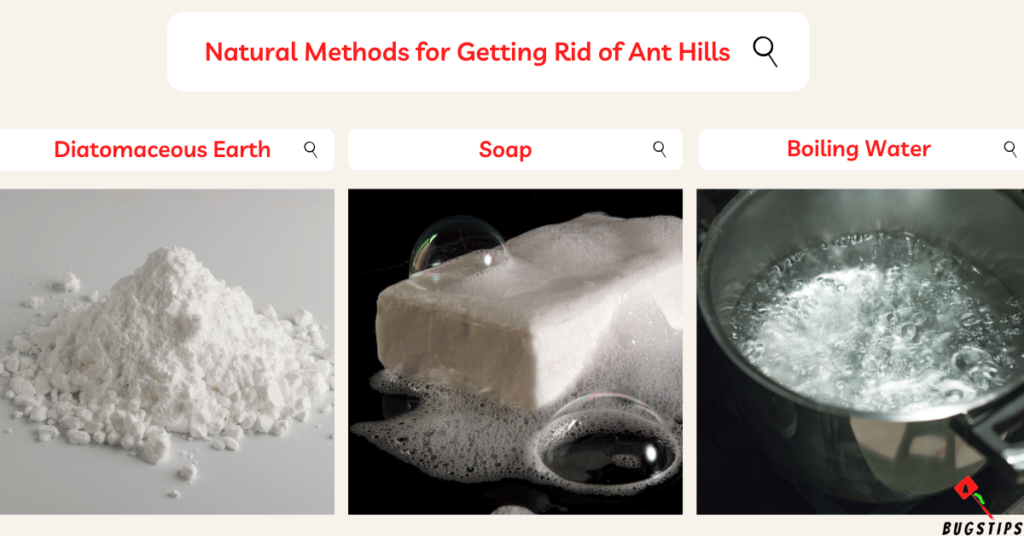
- Diatomaceous Earth
Diatomaceous earth is a natural powder made from the fossilized remains of tiny aquatic organisms called diatoms. To use it for getting rid of ant hills, sprinkle the powder directly onto and around the ant mound.
The sharp edges of the diatoms cut through the ant’s exoskeleton, leading to dehydration and death. Be sure to use food-grade diatomaceous earth and wear a mask while applying it to avoid inhaling the fine dust.
- Soap
Soap can also be used as a natural method to get rid of ant hills. Mixing a solution of water and liquid dish soap can effectively kill ants on contact. Simply mix one part soap with three parts water in a spray bottle and spray the solution directly onto the ant hills.
The soap will break down the ant’s exoskeleton, leading to dehydration and death. It is important to note that this method only kills the ants it comes into contact with and does not provide long-term residual control.
- Boiling Water
Boiling water is a simple and effective way to kill ant hills. It involves pouring boiling water directly onto the ant mound to kill the ants and destroy the colony. This method works best on small ant hills, and it’s important to take proper safety precautions, such as wearing gloves and being careful not to splash the boiling water onto yourself or others.
It’s also important to note that boiling water may damage plants or grass surrounding the ant mound, so it’s best to use this method in areas where you don’t mind killing the vegetation.

- Vinegar
Vinegar can also be an effective natural method for getting rid of ant hills. The strong smell of vinegar can help to disrupt ants’ scent trails and make it harder for them to navigate. You can make a vinegar solution by mixing equal parts of water and vinegar and spraying it directly on the ant hills.
Alternatively, you can also pour the solution directly into the ant hill. However, be aware that vinegar can also harm nearby plants and grass, so use it carefully and sparingly.
- Cinnamon
Cinnamon is a natural ant repellent because it interferes with their sense of smell. To use cinnamon to get rid of ant hills, you can sprinkle it around the mound or create a cinnamon barrier around your home or garden to keep ants from entering.
You can also mix cinnamon powder with water to create a spray and apply it directly to the ant hills. However, keep in mind that cinnamon may not kill ants, it just keeps them away.
- Coffee grounds
Coffee grounds can also be used as a natural way to repel ants. Simply sprinkle coffee grounds around the ant hill or any areas where ants are present.
The strong smell of coffee will mask the scent trails that ants use to navigate, making it difficult for them to find food and water sources in your yard. Additionally, the acidity in coffee can also be harmful to ants.
Manual Methods for Getting Rid of Ant Hills
If you prefer manual methods for getting rid of ant hills, there are a few options available.
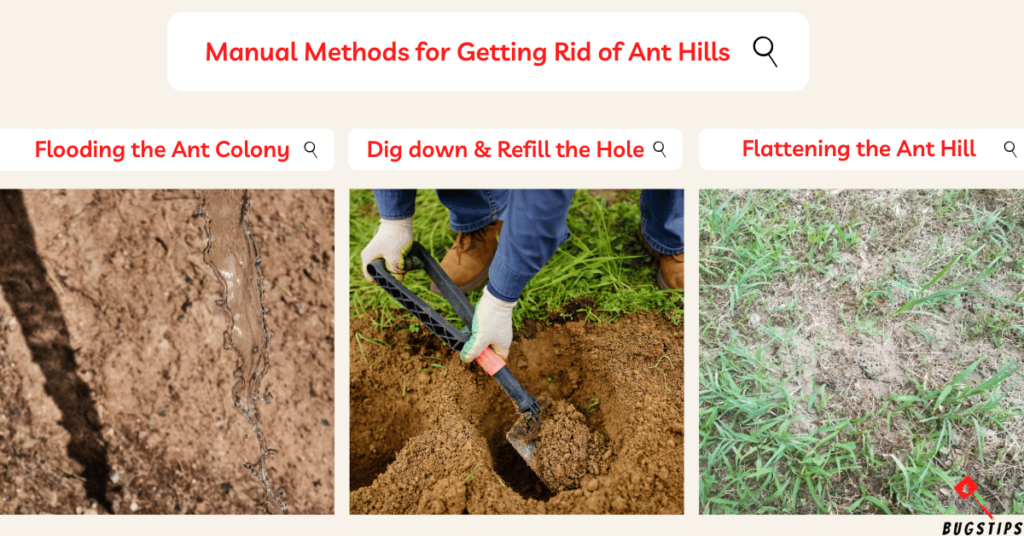
- Flooding the Ant Colony
Flooding the ant colony is a simple and effective method for getting rid of ant hills. The idea behind this method is to flood the colony with water, which will cause the ants to evacuate and drown.
To do this, you can use a garden hose or bucket of water to pour directly into the ant hill. Make sure to pour enough water to reach the bottom of the hill to ensure the entire colony is flooded.
It’s important to note that this method may not be effective for larger colonies or colonies that are located near water sources, as the ants may be able to relocate to higher ground.
- Dig down to the Bottom and Refill the Hole
To get rid of ant hills by digging down to the bottom and refilling the hole, you will need a shovel or digging tool. Start by digging around the ant hill to expose the main tunnel. Once you have found the main tunnel, carefully dig down to the bottom of the tunnel and remove the queen and the larvae.
After that, fill the hole with dirt and tamp it down to ensure that the ground is level. This method can be effective in removing the ant colony, but it requires some physical labor and may not be practical for larger ant hills.
- Flattening the Ant Hill
Flattening the ant hill is a simple and effective manual method for getting rid of ant hills. All you need to do is use a shovel or a similar tool to flatten the ant hill, making sure to destroy any tunnels or openings in the process.
This will not only destroy the ants’ home but also damage their food and water supply, forcing them to relocate. However, it’s important to note that this method may not work for larger ant colonies and could result in the ants rebuilding their hill in the same location.
You May Also Like – Do Ants Like Heat? The Truth About Ants and Heat
Special Method: Pouring Aluminum into Ant Hill: Step-by-Step Guide
If you’re looking for a unique way to create art while also revealing the hidden structure of an ant colony, pouring aluminum into an anthill might just be what you need.
However, it's important to note that this process involves high temperatures and should only be attempted by professionals or experienced individuals in handling molten metal.
If you still want to try this out by yourself, we have prepared a step-by-step guide to help you. Just remember to exercise extreme caution and take all necessary safety measures before attempting this process.
Before attempting this process, it is important to have the necessary tools and materials. You will need fire bricks, a furnace blower, a heat-resistant container to melt the aluminum, and protective gear such as gloves and goggles.
- Prepare the anthill by removing any debris or dirt from the entrance and surrounding area. This will help ensure a clean and clear mold.
- Next, prepare the forge by arranging fire bricks in a semi-circle and aiming a furnace blower at the opening. The forge will create the intense heat needed to melt the aluminum.
- Once the forge is ready, heat the aluminum until it reaches a temperature of 1,400 degrees Fahrenheit. This is the melting point of aluminum and is necessary to create a mold of the ant hill.
- Carefully pour the molten aluminum into the ant hill entrance, filling it completely. It is important to exercise caution during this step as the aluminum is extremely hot and can cause severe burns.
- Allow the aluminum to cool and harden, which usually takes a few hours. Once the aluminum has completely hardened, excavate the sculpture and blast it with water to remove dirt and impurities.
- The final piece will reveal the intricate tunnels and chambers that make up the ant hill. It can be used as a unique and fascinating piece of art or as a scientific study tool.
Pouring aluminum into an ant hill is not only a unique and fascinating way to create art but also a method to get rid of an ant colony.
How to Prevent Future Ant Hills from Forming
Ant hills can be a nuisance in your yard and may cause damage to your plants and property. While it’s important to know how to get rid of existing ant hills, it’s also crucial to take preventive measures to avoid new ones from forming.
So here we’ll share some effective methods for preventing future ant hills from appearing in your yard.
- Mowing the Grass
Mowing the grass regularly is a simple and effective way to prevent ants from building nests in tall grass. By keeping the grass short, you remove potential hiding places for ants and limit their ability to build colonies.
Make sure to mow your lawn frequently during the ant season to keep these pests at bay.
- Removing food sources
Ants are attracted to food sources, so it’s important to eliminate any potential sources of food or food waste on your property. This can include properly storing food in sealed containers, cleaning up crumbs and spills, and disposing of garbage in sealed bags.
By removing these food sources, you can discourage ants from building their nests in your yard.
- Limiting water sources
Limiting water sources is another effective method for preventing future ant hills. Ants need water to survive, so removing standing water or fixing leaks around your property can help discourage them from building nests.
This can be done by regularly checking your property for any sources of water that may attract ants and fixing them as soon as possible. Simple actions like fixing leaky pipes, filling in puddles, and using proper drainage techniques can go a long way in preventing future ant infestations.
- Trimming vegetation
Trimming vegetation involves cutting back plants and bushes to reduce the areas where ants can build their nests. Overgrown vegetation can provide an ideal habitat for ants to thrive, so keeping it under control is crucial in preventing future ant hills.
This method not only limits the ant’s nesting area but also makes it easier to spot and treat any new mounds that may pop up.
- Using Defensive Bait
Using defensive bait is another effective method to prevent future ant hills from forming. Bait traps can be strategically placed in areas where ants are likely to travel, such as near the foundation of your house or along the edges of your property.
The bait will attract the ants and poison them, eliminating the colony before they can establish a new nest. It’s important to use caution when placing bait traps, as they can be harmful to pets and children if not handled properly.
Final Thoughts
If you’re dealing with ant hills in your yard, there are various methods you can choose from, including chemical and natural remedies. As we discussed, some methods involve extreme caution, like pouring aluminum into the colony, while others are more simple, like mowing the grass and removing food sources.
However, prevention is the key to avoiding future ant hills from forming in your yard. By following the tips we’ve discussed, you can reduce the likelihood of ants building their nests in your property.
It’s also important to exercise caution and safety measures when attempting to eliminate ant hills and to seek professional help if necessary. With these tips, you can maintain a beautiful and ant-free yard. For more detailed information on ant hills, be sure to read our comprehensive article on the topic. – Exploring Ant Hills: A Comprehensive Guide
FAQs
Why are there so many ant hills on my driveway?
Ants often build their nests in dry, sunny areas, such as driveways. The warmth of the sun helps to incubate and protect their eggs.
How do I get rid of ant hills in my mulch?
To get rid of ant hills in mulch, you can use natural methods such as pouring boiling water or vinegar over the colony, or using a natural insecticide like diatomaceous earth. You can also use chemical insecticides, but be sure to follow the instructions carefully.
How do I kill ants around an anthill?
You can kill ants around an anthill by using a natural insecticide or a chemical insecticide. You can also try pouring boiling water or vinegar over the colony.
How can I get rid of an ant hill without disturbing it?
One way to get rid of an ant hill without disturbing it is to use a natural insecticide like diatomaceous earth or boric acid.
What do I do if I have multiple anthills?
If you have multiple anthills, you can use the same methods to get rid of them as you would for a single anthill. However, you may need to use more insecticide or larger quantities of natural remedies.
Will bleach or gasoline/fire kill an anthill?
Bleach, gasoline, and fire are not recommended methods for killing an anthill. They can be dangerous and may harm the environment. Instead, use natural insecticides or chemical insecticides according to the instructions.
Can I just step on an ant hill to destroy It?
Stepping on an ant hill may kill some of the ants, but it is not an effective way to get rid of the entire colony. Ants have a complex network of tunnels and chambers that can extend several feet underground.
Does pouring vinegar on ant hills kill them?
Yes, pouring vinegar on ant hills can kill the ants. The acid in the vinegar disrupts the ants’ scent trails and can kill them on contact.
Can I spray raid on an ant hill?
It’s not recommended to spray Raid directly on an ant hill. because it could potentially worsen the ant infestation instead of eliminating it.
How much vinegar does it take to kill ant Hill?
The amount of vinegar needed to kill an ant hill depends on the size of the colony. For a small colony, a cup of vinegar may be sufficient, while a larger colony may require several cups. It’s important to pour the vinegar directly into the ant hill and to repeat the process if necessary.
Resources – (for further reading)
National Library of Medicine – Factors affecting distribution of the mound-building ant Lasius neoniger (Hymenoptera: Formicidae) and implications for management on golf course putting greens
National Library of Medicine – Targeted Removal of Ant Colonies in Ecological Experiments, Using Hot Water
Iowa State University – How to Manage Ant Mounds in Lawns, Gardens, and Pastures
Instructables – Casting an Aluminum Anthill : 8 Steps (with Pictures)

